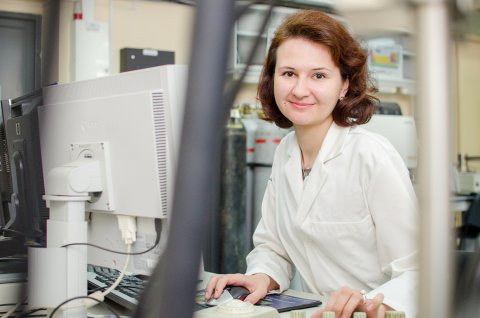A project by the South Ural State University scientists aims at elaborating a physical-and-chemical background for production of barium-hexaferrite-based single crystals to be further adapted to designation and characteristics of certain microwave electronics devices.
Modern engineering and industry are in need of the wide range of properties of man-made crystals. Svetlana Gudkova, Senior Research Associate at the Crystal Growth Laboratory of “Nanotechnologies” Research and Education Center, jointly with a team of scientists is working on creating a functional single-crystalline material for microwave electronics operated at the frequency of up to 100 GHz. Svetlana Alexandrovna was awarded a grant for her research having won Support for Young Science contest held under Project 5-100.
A distinctive feature of this research is producing of manganese-alloyed barium and strontium hexaferrites, and studying of their properties. Barium hexaferrite has been known to the scientific community since the 50’s, but it was used only as permanent magnet back then.
“From our school chemistry lessons we remember that barium hexaferrite has quite a simple gross formula: ВаFе12019. Its crystalline lattice comprises 12 ferrum atoms with 5 various positions within the lattice.”
A ferrous ion is characterized with a big value of magnetic moment and it defines the magnetic properties of barium hexaferrite lattice. The SUSU scientists are replacing these ferrous ions in the barium hexaferrite lattice with manganese ions. Why? That is required to alter ferromagnetic resonance frequency in the crystalline lattice and vary the size of the latter.

“For a “clean” common lattice, ferromagnetic resonance frequency equals 50 GHz (gigahertz). If we replace ferrous ions with manganese ions, this frequency will be decreasing. If we replace ferrum with aluminium, the frequency will be increasing. The possibility of controlling the alteration of resonance frequency allows to use barium hexaferrite in various electronic devices,” shares Svetlana Alexandrovna.
Not so long ago, Svetlana has discovered an interesting field of application for the modified barium hexaferrite:
“In Chelyabinsk, as well as in other Russian megapolises, there are many various social institutions and residential houses with cellular towers installed on their roofs. Adding of powdered modified barium hexaferrite into the roof coating composition could protect the population against radiation exposure from them.”
This idea has only been developed in theory yet, but there are quite real possibilities for application of such modification:
“Of course, using modified barium hexaferrite we can make all equipment literally “invisible” for radiation. We can reduce exposure of human body to radiation from microwave ovens by designing, for instance, some protective screen or a protective polymer cover panel manufactured with the use of single-crystalline materials,” explains Svetlana Gudkova.
The modified barium hexaferrite may be used as an absorber of radiation from devices operated at various frequencies, and vice versa as a source of high-frequency signals. The field of application of the modified barium hexaferrite is very broad: from the military-and-industrial sector to radio engineering and electronics. Meanwhile, the material itself may be manufactured either in the form of powder coating, or in the form of separate parts of devices.
“Barium hexaferrite lattice has been known long ago. It is just that for a certain period of time people did not really know what to do with it. Its “new life” began in the 80’s of the past century when manufacturers started to use it in computer hard drives. Before that, barium hexaferrite had been used in industry in the form of powders; what we do now is grow single crystals and find applications for them.”
The SUSU scientists can predict the properties of single crystals, and create single-crystalline materials with different targeted properties along various crystallographic directions. Scientists call is anisotropy of properties (when properties of a material depend on a crystallographic direction).
Once the scientists have grown a crystal, they start studying it: they perform a complex research of the structure and properties of the materials in order to prove the applicability of single crystals in certain electronic devices.
To fulfill their project, the researchers are developing external collaborations with the world leading scientists in the field of inventing and studying materials, and are publishing joint articles and participating in contests and conferences. Since they have been successfully interacting with such research centers as MIPT, Lomonosov Moscow State University, ETU “LETI”, MIREA, MISIS as partners, as well as with the world leading laboratories in Germany, Finland and Taiwan, we may claim that single crystals produced by these scientists can stand competition at the scientific research market and the world leading scientists are showing interest in them.




